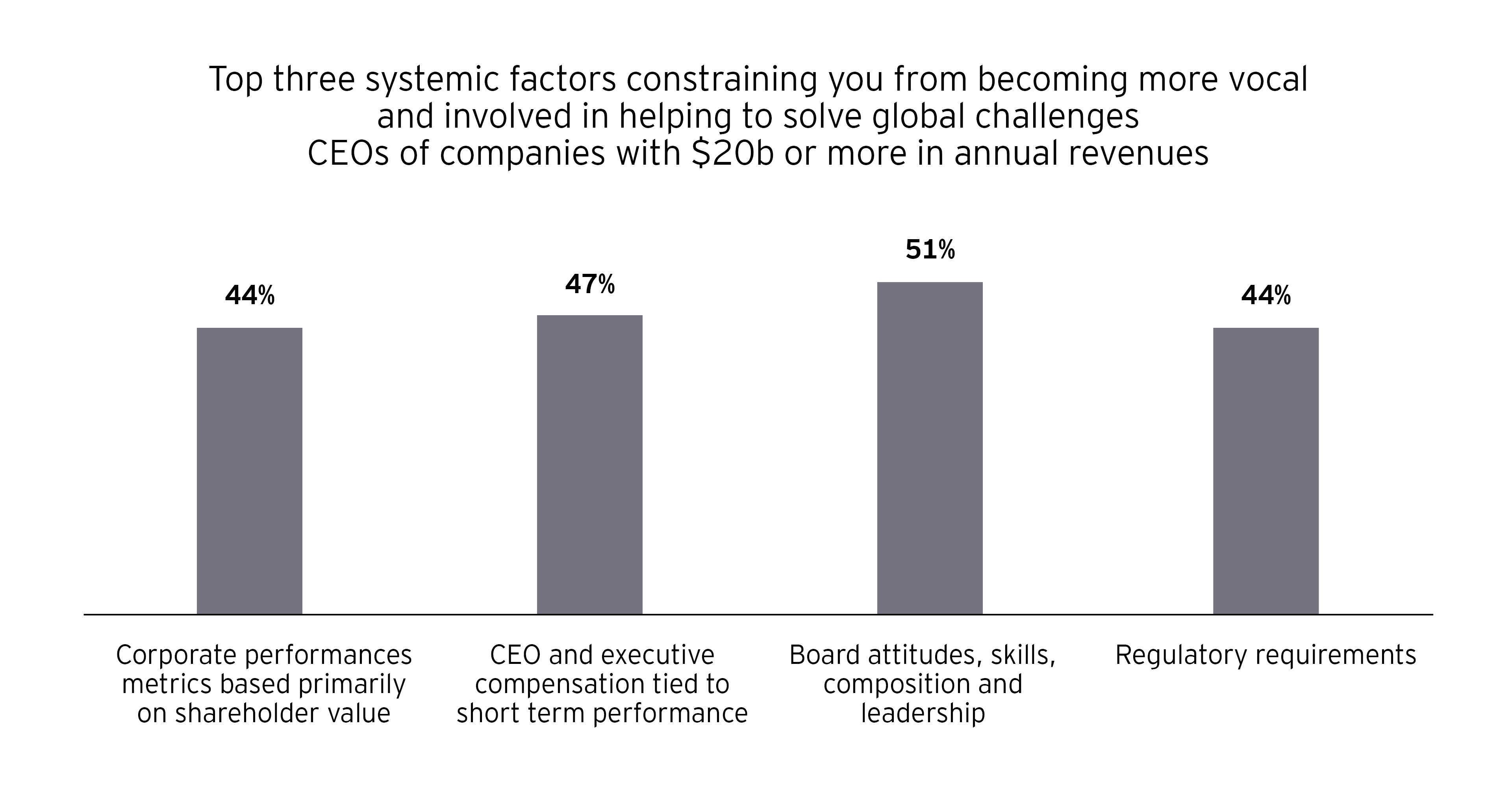60% of CEOs surveyed say that addressing global challenges will provide greater growth opportunities than risk to the business over the long term.
A future-back vision of innovation drives transformation
Stakeholder demand to address global challenges presents incredible opportunities for companies to develop innovative solutions that stakeholders can rally behind as both the brand and products align to their values. Companies can use this momentum to further pursue innovation initiatives, driving transformation from within to support and scale new solutions, disrupting themselves and creating a better future for all stakeholders.
To develop these innovative solutions, companies first need to identify the opportunities. Using a future-back approach, companies can explore how global challenges and megatrends (pdf) may impact the future. By applying design thinking about the life of both customers and non-customers, companies can then design a solution to improve their lives today, either by leveraging existing products and services, or by inventing something totally new.

In developing a future-back vision, companies must bring the outside-in. This involves understanding how global challenges and megatrends are impacting customer expectations, employee desires to work for a purposeful company and stakeholders who can facilitate a right-to-operate in new ways.
Companies also need to bring the inside-out. This starts by reimagining the core business model and business practices, and expanding out into the external ecosystem of partners, stakeholders and wider society.
Companies that are agile in development, close to the customer and fast to market are better able to spot opportunities and deliver products to the market before the competition. Companies that can identify customers’ changing preferences, such as supporting products that address global challenges such as reducing climate pollution and waste, are rewarded by the market. Some examples of these successful companies include:
- A footwear company that uses renewable and recyclable material to make its sneakers. The company received its latest round of funding based on a valuation of US$1.4b.
- A plant-based food company valued at US$9b that offers meat alternatives that can appeal to both vegetarians and omnivores.
- An eyewear company, valued at US$1.8b, and made famous for online ordering so customers can try the eyewear from the comfort of their homes, donates a pair of glasses for every pair purchased to those in need.
Each company identified growing customer demand for environmentally sustainable, animal-conscious or socially supportive products early on and set out to design solutions to meet these needs. These smaller companies highlight the opportunity to solve for the future while developing profitable products today. By identifying the megatrends and developing future-back scenarios, large corporations can capitalize on these opportunities as well.
New business models can transform entire industries — and societies
To seize the upside of disruption and take advantage of the opportunities embedded in addressing global challenges, companies need to reinvent business models and value ecosystems. This requires new capabilities and approaches to traditional strategic planning, as well as a leadership and culture shift within organizations — being close to the customer, agile in development and fast to market. The resulting growth from addressing global challenges has the ability to transform societal and economic systems around the business.
For example, in addressing the need for mobility, a ride-sharing company disrupted the existing transportation industry with a solution that changed mobility as we knew it. They created a service that matched supply and demand and established a simple method for earning money through flexible means. As ground zero for the “gig economy,” this company’s business model has transformed entire industries, from shopping to food and home services. It has also empowered individuals to earn additional income outside of traditional employment structures.
According to a recent Upwork Freelancing in America study, more than one-third of US workers participate in the gig economy. By 2020, The International Labor Organization says gig workers will account for 43% of the US workforce. The gig economy is here to stay and will continue to evolve as a way for individuals with under-paying jobs to make ends meet on flexible terms.
Although companies do not have a direct impact on how much a teacher, social worker or other critical professions within society make, they can empower their ability to earn additional income outside of traditional careers. Solving a problem can turn into a multi-billion-dollar business. It also can become the lead domino for innovation across society, empowering people and helping to address global challenges.
Solving global challenges can be profitable
Despite their desire to develop innovative solutions that address global challenges, CEOs recognize the systemic constraints working against them. These can include: corporate performance metrics based primarily on short term share price; CEO and executive compensation tied to short-term performance; board attitudes, skills, composition and leadership; and regulatory requirements.

These challenges present CEOs and their executive teams with a “duality dilemma.” Business leaders are expected to deliver on near-term business demands while developing strategies to cope with and even drive future disruptions. Yet, companies that make an investment in purpose and work to solve global challenges can radically transform their business and drive new sources of revenue. Fortunately, with 60% of institutional investors supportive of long-term investments in disruptive initiatives, CEOs have more support than in the past for balancing towards long-term results.
One such example is Royal DSM, a former coal mining company that reinvented itself to fight climate change, malnutrition and resource scarcity. In what Feike Sijbesma, Chief Executive Office of Royal DSM, calls in a recent Forbes article “future proofing,” the company recognized that its existing product line, bulk chemicals, could not continue to thrive in an ever-changing sector. In developing a clear purpose “to create brighter lives for people today and generations to come,” the company created new commercial solutions that drive revenue and help to improve the world. The innovative and environmentally conscious products now make up near two-thirds of the firm’s sales and the stock price has grown four times since the transformation began.
Having a vision of the future helps companies to identify potential opportunities and gain a greater understanding of the playing field in which they can operate. With this knowledge of opportunity and landscape, companies can choose a direction and then work backward to create a roadmap for funding innovation and new capabilities needed to seize the upside of disruption.
To determine where your company stands in its transformation journey, take the Transformative Index Survey. The results can help you to determine actions you can take now, next and beyond.
Read more
Addressing global challenges and creating profitable growth helps to build a better working world
To address global challenges and drive revenue growth, companies must embrace self-disruption. Taking a future-back approach can help companies explore opportunities to invent new business models that can transform the entire market and value system in which they operate.
CEOs who have a future-back vision and can execute in a way that addresses global challenges and sustains profitable growth, will fulfill a growing expectation by investors, customers, employees and other stakeholders. It will also help companies become part of building a better working world.
A future-back vision of innovation drives transformation
Stakeholder demand to address global challenges presents incredible opportunities for companies to develop innovative solutions that stakeholders can rally behind as both the brand and products align to their values. Companies can then use these innovative solutions to self-disrupt, driving further innovation and transformation around the core business and positioning itself for long-term growth.
- Explore how global challenges and megatrends could affect your business long-term. Determine both the downside risks as well as the potential upside opportunities.
- Engage in a future-back visioning process to develop a strategic roadmap for innovation and reinvention around global challenges.
- Bring the outside in to understand the expectations and needs of your stakeholders.
- Bring the inside out to reimagine the core business model and business practices, and then expand out into the external ecosystem of partners, stakeholders and wider society.
- Develop the capabilities needed to reinvent business models and value ecosystems: new strategic planning approaches, a culture shift to being close to the customer, agile in development and fast to market.
- Consciously identify and address your duality dilemma: how you will deliver on near-term business demands while developing strategies drive organizational transformation and market disruption.
Special thanks for his contribution to this article goes to Ryan Canale.
Summary
CEOs see the need for their companies and themselves personally to engage directly and develop solutions for global challenges, such as technology-induced job losses, escalating cyber attacks, and climate change. The EY CEO Imperative Study 2019 found that CEOs consider the top opportunities cited are developing new business models and services, along with attracting top talent.


